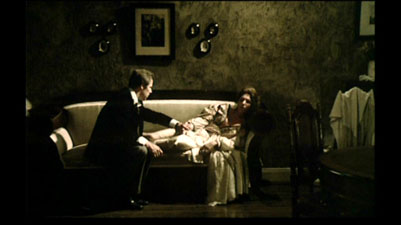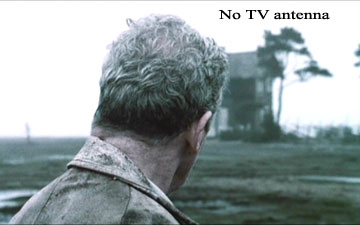
Nostalghia.comThe Sacrifice Redux
This article is a companion piece to the DVDBeaver.com comparison/review of the three DVDs of The Sacrifice currently available: The Kino on Video version (R1/NTSC), the Artificial Eye version (R2/PAL), and the Cinefil/Imagica version (R2/NTSC). We attempt to show that no acceptable version of
The Sacrifice exists on DVD as of this writing (October 2003). We wish to acknowledge
valuable contributions by Steffen Bieker, Keith Rose, Kimitoshi Sato, Per-Olof Strandberg, and the 35mmforum.com.
Brightness and contrast issuesShortly after the very first release of The Sacrifice on DVD, by Kino on Video, we started receiving concerned letters from some of our readers — a common complaint was that the color temperature was seemingly "off." When Artificial Eye subsequently released their own version of the film, it became clear that it too suffered from the same suspected problem. To illustrate, take the following scene, where we show a screenshot from the Kino release on the left and the corresponding frame from the Artificial Eye release on the right; they look virtually identical:
The problem here is that this is not what many of us remember seeing in the theatre... A somewhat darker and more muted tone would seem more appropriate in this scene. For the longest time, the only "proof" of this (beyond vague memories from having once seen it in the theatre) was that Michal Leszczylowski's documentary Directed by Andrei Tarkovsky, included on both discs, in quoting this exact scene reproduces it as follows:
This is closer to the correct atmosphere, but it does seem to be a bit too much on the dark side — not surprising since it is after all a mere quote within the context of a larger documentary and no effort has presumably been put into faithfully representing the scene. Enter the Japanese Cinefil/Imagica release. The Japanese, in our books famous for their attention to detail, actually appear to have gotten the color temperature spot-on:
Many would agree that the above left screenshot is closest to what they observed when seeing the film in the theatre. (Shown on the right, for reference purposes, is a screengrab from a Japanese TV broadcast.) This awful luminosity/contrast-boosting seen on the Kino and Artificial Eye releases has another unfortunate side effect: a loss of image detail due to the finite dynamic range of the medium. The following image pair shows, as just one example, how the Japanese release faithfully reproduces the out-of-focus TV antenna on the roof of the house (left), while the Kino and Artificial Eye DVDs show no antenna at all (right). Also note the tree branches. This is clearly unacceptable treatment of a work of Art. (Click on images for larger versions.)
If the Japanese version had come in an anamorphic transfer this would indeed have been the ultimate The Sacrifice DVD, from an image-quality point of view. It is, regrettably, letterboxed. Neither does it carry English subtitles. Moreover, among the three discs discussed, it is the only one to suffer from PAL-speedup (the film runs 4% too fast). Only the Artificial Eye DVD has an anamorphic transfer of the film; the encoding is however seriously flawed, in certain cases actually rendering the film less well-defined (i.e., more blurry) than its non-anamorphic counterpart from Kino on Video. This is the topic of our next section. Video encoding problems
When asked to comment on the issue, Artificial Eye stated that
they had used a brand new DigiBeta copy recently obtained from
the Swedish Film Institute (SFI), and that if there should be
a problem with the disc, the blame would reside with the SFI.
The SFI has stated, on at least one occasion, that nothing could possibly
be wrong with the DigiBeta that was delivered to AE, as the
master tape has been made at SFI's very best laboratory facility, using
only the best in modern technology, and that it would be next to impossible to
further improve upon it.
Artificial Eye and the Swedish Film Institute are thus pointing the finger at each other,
and, as it stands now, we do not know who is at fault...
Flawed source elements
ConclusionIt does in actual fact not require a significant effort to get any film made within the past 20 years to DVD without such artifacts, glitches and flaws. Nevertheless, here we are today without a single satisfactory DVD version of Tarkovsky's most recent film. The good news is that the SFI is currently (autumn 2003) in the process of re-mastering The Sacrifice for DVD. If anyone is in a position to create the Ultimate Offret DVD (maybe even a Box Set — one may dream), it would surely be the Swedish Film Institute. We are looking forward to this upcoming release of Andrei Tarkovsky's The Sacrifice with breathless anticipation. [SEE MARCH 4 2004 UPDATE IN PREAMBLE]
|










